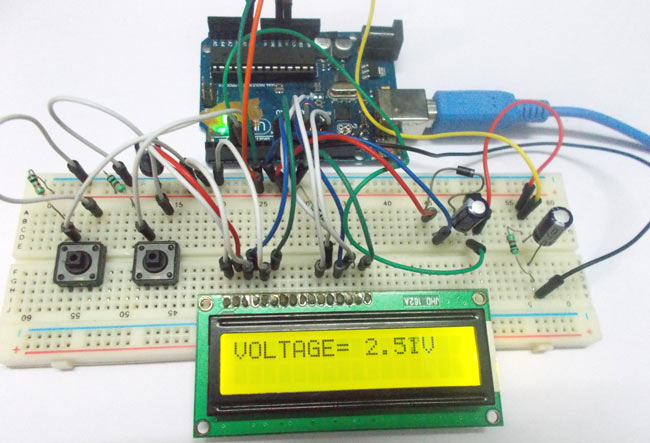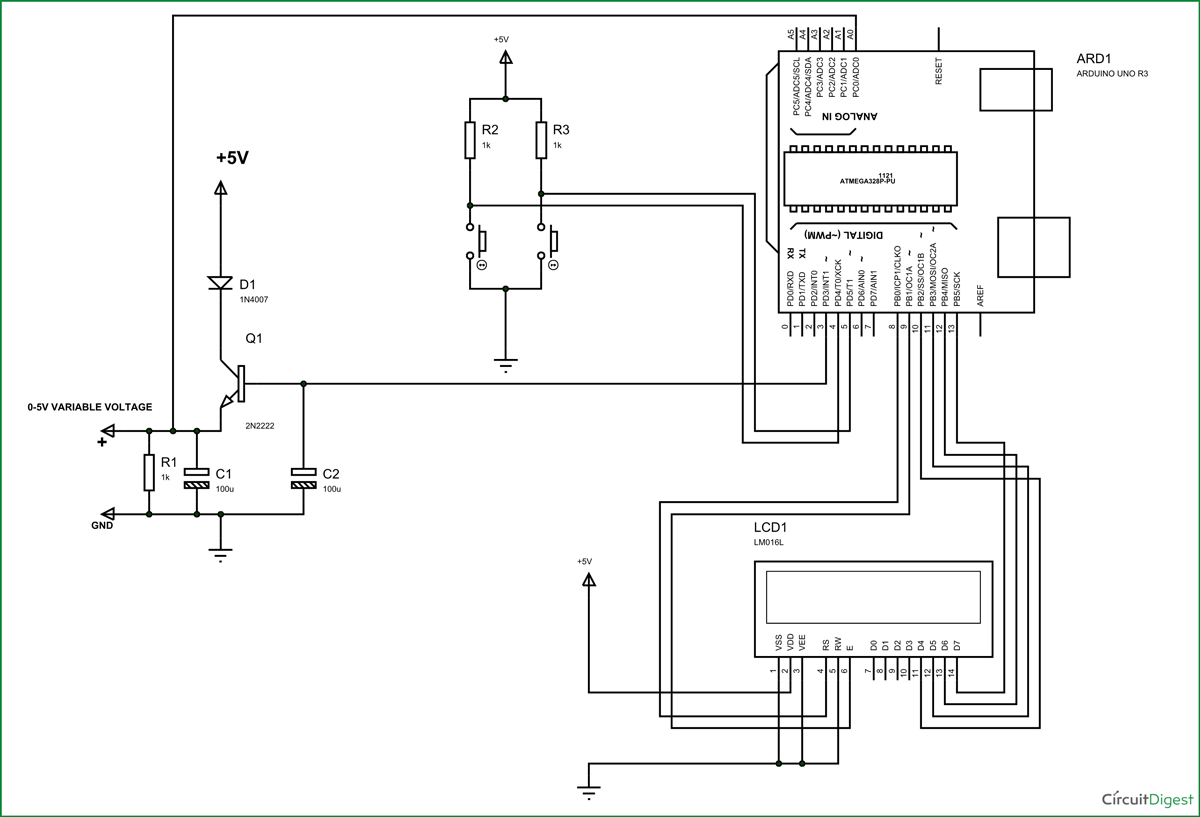
In this tutorial we will develop a 5V variable voltage source from Arduino Uno. For that we are going use ADC (Analog to Digital Conversion) and PWM (Pulse Width Modulation) feature.
Some digital electronic modules like accelerometer work on voltage 3.3V and some work on 2.2V. Some even work on lower voltages. With this we cannot get a regulator for every one of them. So here we will make a simple circuit which will provide a voltage output from 0-5 volts at a resolution of 0.05V. So with this we may provide voltages accurately for the other modules.
This circuit can provide currents up to 100mA, so we can use this power unit for most of the sensor modules without any trouble. This circuit output can also be used to charge AA or AAA rechargeable batteries. With the display in place we can easily see the power fluctuations in the system. This variable power supply unit contains button interface for the voltage programming. The working and circuit is explained below.
Hardware: Arduino Uno, Power supply (5v), 100uF capacitor (2 pieces), button (2 pieces), 1KΩ resistor (3 pieces), 16*2 characters LCD, 2N2222 transistor.
Software: Atmel studio 6.2 or AURDINO nightly.
Circuit Diagram and Working Explanation
The circuit for variable voltage unit using arduino is shown in below diagram.
The voltage across output is not completely linear; it will be a noisy one. To filter out the noise capacitors are placed across output terminals as shown in figure. The two buttons here are for voltage increment and decrement. The display unit shows the voltage at the OUTPUT terminals.
Before going for working we need to look into ADC and PWM features of Arduino UNO.
Here we are going to take the voltage provided at the OUTPUT terminal and feed it into one of ADC channels of Arduino. After conversion we are going to take that DIGITAL value and we will relate it to voltage and show the result in 16*2 display. This value on display represents the variable voltage value.
ARDUINO has six ADC channels, as show in figure. In those any one or all of them can be used as inputs for analog voltage. The UNO ADC is of 10 bit resolution (so the integer values from (0-(2^10) 1023)).This means that it will map input voltages between 0 and 5 volts into integer values between 0 and 1023. So for every (5/1024= 4.9mV) per unit.
Here we are going to use A0 of UNO.
|
First of all the UNO ADC channels has a default reference value of 5V. This means we can give a maximum input voltage of 5V for ADC conversion at any input channel. Since some sensors provide voltages from 0-2.5V, with a 5V reference we get lesser accuracy, so we have a instruction that enables us to change this reference value. So for changing the reference value we have (“analogReference();”) For now we leave it as.
As default we get the maximum board ADC resolution which is 10bits, this resolution can be changed by using instruction (“analogReadResolution(bits);”). This resolution change can come in handy for some cases. For now we leave it as.
Now if the above conditions are set to default, the we can read value from ADC of channel ‘0’ by directly calling function “analogRead(pin);”, here “pin” represents pin where we connected analog signal, in this case it would be “A0”.
The value from ADC can be taken into an integer as “float VOLTAGEVALUE = analogRead(A0); ”, by this instruction the value after ADC gets stored in the integer “VOLTAGEVALUE”.
The PWM of UNO can achieved at any of pins symbolized as “ ~ ” on the PCB board. There are six PWM channels in UNO. We are going to use PIN3 for our purpose.
|
analogWrite(3,VALUE); |
From above condition we can directly get the PWM signal at the corresponding pin. The first parameter in brackets is for choosing the pin number of PWM signal. Second parameter is for writing duty ratio.
The PWM value of UNO can be changed from 0 to 255. With “0” as lowest to “255” as highest. With 255 as duty ratio we will get 5V at PIN3. If the duty ratio is given as 125 we will get 2.5V at PIN3
As said earlier there are two buttons connected to PIN4 and PIN5 of UNO. On press the duty ratio value of PWM will increase. When other button is pressed the duty ratio value of PWM decreases. So we are varying the duty ratio of PWM signal at PIN3.
This PWM signal at PIN3 is fed to the base of NPN transistor. This transistor provides a variable voltage at its emitter, while acting as a switching device.
With the variable duty ratio PWM at base there will be variable voltage at emitter output. With this we have a variable voltage source at hand.
The voltage output is feed to UNO ADC, for the user to see the voltage output.
#include <LiquidCrystal.h>
LiquidCrystal lcd(8, 9, 10, 11, 12, 13);//RS,EN,D4,D5,D6,D7
int voltageadjust =125;//starting initial variable output at 2.5V
float check =0;
void setup()
{
pinMode(3,OUTPUT);//PWM output pin
pinMode(4,INPUT);//button 1
pinMode(5,INPUT);//button 2
lcd.begin(16, 2);//number of characters on LCD
// Print a logo message to the LCD.
lcd.print(" CIRCUITDIGEST");
lcd.setCursor(0, 1);
delay (2500);
delay (2500);
lcd.clear();
lcd.print("VOLTAGE= ");//printing name
lcd.setCursor(9, 0);
}
void loop()
{
float VOLTAGEVALUE = (analogRead(A0));//read ADC value at A0
VOLTAGEVALUE = (VOLTAGEVALUE*5)/1024;//converting digital value to voltage
if ((check > (VOLTAGEVALUE+0.05))|(check < (VOLTAGEVALUE-0.05)))
// if voltage change is higher or lower than 0.5 of previous value (to avoid fluctuations)
{
lcd.print(VOLTAGEVALUE);
lcd.print("V ");
lcd.setCursor(9, 0);//go to position 9 on LCD
check = VOLTAGEVALUE;//store previous value
}
analogWrite(3,voltageadjust);//provide PWM at PIN3
if (digitalRead(4)==LOW)
{
if (voltageadjust<250)
{
voltageadjust++;//if button1 is pressed and value is less than 250 increment the PWM value
delay(30);
}
}
if (digitalRead(5)==LOW)
{
if (voltageadjust>0)
{
voltageadjust--;// if button2 is pressed and value is greater than 0 decrement the PWM value
delay(30);
}
}
delay(200);
}
Comments
I have built it on bread
I have built it on bread board and its working, although I didn't try to simulate it on Proteus.
problem with this circuit
There is basic and major design problem with pwm based supply. They cant goto zero properly. specially if you are switching higher voltage. For that you also needs to change voltage of pwm at lower ends, like 1%. if you goto zero it will fluctuate.
to make without arduino uno
hello, i want to do this project but without using arduino board , instead using atmega8. plz can somebody help, how will be circuit diagram
Cntroling of robot arm using potentiometer
Hi, guys, I am working on a Scorbot ER-V plus, I am controlling the joint position by a linear potentiometer in place of encoder it is working and I got some variation at fixed position how can I control that fluctuation in joint position how can we modified the feedback rate by Arduino.
how to increase my power supply voltage 0-5v to 15V ?
please help me to how can i increase input power supply to 15V dc ?if i want to increase power supply what will be the modification of my arduino code and other parts of circuit ?
request:arduino automatic voltage stabilizer
i have learnt alot in ur tutorial.thanks alot
Hi! Great project! A
http://www.novreczky.eu/belimo/pdf/trd24sr.pdfHi! Great project! A question regarding the schematics. I need to generate 0…10V DC to control this rotary actuator: http://www.novreczky.eu/belimo/pdf/trd24sr.pdf Do I need to change the R1’s value to make it work at VMaxOutput=10V? Make it 2K (since the max voltage is 2x higher)? Thanks!







Hi. I already done this circuit design as shown in your circuit diagram on Proteus 8. The lcd is working but there is no output for PWM. Can i know why ? is it related to the given coding ?